EDIT:
I finally found a real simple solution to this problem, using the CAGradientLayer class, and the CALayer drawing functionalities.
Ole Begemann released a great UIView wrapper for CAGradientLayer class named OBGradientView.
This class allows you to easily create a gradient UIView in your application.
You then use the CALayer drawing functionalities to add the rounded corners and drop shadow values :
// Create the gradient view
OBGradientView *gradient = [[OBGradientView alloc] initWithFrame:someRect];
NSArray *colors = [NSArray arrayWithObjects:[UIColor redColor], [UIColor yellowColor], nil];
gradient.colors = colors;
// Set rounded corners and drop shadow
gradient.layer.cornerRadius = 5.0;
gradient.layer.shadowColor = [UIColor grayColor].CGColor;
gradient.layer.shadowOpacity = 1.0;
gradient.layer.shadowOffset = CGSizeMake(2.0, 2.0);
gradient.layer.shadowRadius = 3.0;
[self.view addSubview:gradient];
[gradient release];
Dont forget to add the QuartzCore framework to your project.
ORIGINAL QUESTION:
I have been working on a custom control that is a rounded rectangle button, filled with a linear gradient, and having a drop shadow. I have filled the two first steps using this answer : link text
My problem is now to add a drop shadow under the resulting shape. Actually, the context has been clipped to the rounded rect path, so when I use the CGContextSetShadow function, it doesn't draw it.
I tried to solve this problem by drawing the rounded rect twice, first with a plain color, so it draws the shadow, and then redraw it with the gradient fill.
It kinda worked, but I still can see a few pixels at the corners of the shape resulting from the first draw with a plain color, as you can see on this zoomed version :
http://img269.imageshack.us/img269/6489/capturedcran20100701192.png
It is almost good, but not perfect yet...
Here is my -drawRect: implementation :
static void addRoundedRectToPath(CGContextRef context, CGRect rect, float ovalWidth, float ovalHeight)
{
float fw, fh;
if (ovalWidth == 0 || ovalHeight == 0) {
CGContextAddRect(context, rect);
return;
}
CGContextSaveGState(context);
CGContextTranslateCTM (context, CGRectGetMinX(rect), CGRectGetMinY(rect));
CGContextScaleCTM (context, ovalWidth, ovalHeight);
fw = CGRectGetWidth (rect) / ovalWidth;
fh = CGRectGetHeight (rect) / ovalHeight;
CGContextMoveToPoint(context, fw, fh/2);
CGContextAddArcToPoint(context, fw, fh, fw/2, fh, 1);
CGContextAddArcToPoint(context, 0, fh, 0, fh/2, 1);
CGContextAddArcToPoint(context, 0, 0, fw/2, 0, 1);
CGContextAddArcToPoint(context, fw, 0, fw, fh/2, 1);
CGContextClosePath(context);
CGContextRestoreGState(context);
}
- (void)drawRect:(CGRect)rect
{
CGContextRef context = UIGraphicsGetCurrentContext();
CGSize shadowOffset = CGSizeMake(10.0, 10.0);
CGFloat blur = 5.0;
rect.size.width -= shadowOffset.width + blur;
rect.size.height -= shadowOffset.height + blur;
CGContextSaveGState(context);
addRoundedRectToPath(context, rect, _radius, _radius);
CGContextSetShadow (context, shadowOffset, blur);
CGContextDrawPath(context, kCGPathFill);
CGContextRestoreGState(context);
addRoundedRectToPath(context, rect, _radius, _radius);
CGContextClip(context);
CGFloat colors[] =
{
_gradientStartColor.red, _gradientStartColor.green, _gradientStartColor.blue, _gradientStartColor.alpha,
_gradientEndColor.red, _gradientEndColor.green, _gradientEndColor.blue, _gradientEndColor.alpha
};
size_t num_locations = 2;
CGFloat locations[2] = { 0.0, 1.0 };
CGColorSpaceRef rgb = CGColorSpaceCreateDeviceRGB();
CGGradientRef gradient = CGGradientCreateWithColorComponents(rgb, colors, locations, num_locations);
CGRect currentBounds = self.bounds;
CGPoint gStartPoint = CGPointMake(CGRectGetMidX(currentBounds), 0.0f);
CGPoint gEndPoint = CGPointMake(CGRectGetMidX(currentBounds), CGRectGetMaxY(currentBounds));
CGContextDrawLinearGradient(context, gradient, gStartPoint, gEndPoint, 0);
CGColorSpaceRelease(rgb);
CGGradientRelease(gradient);
}
Any ideas on how to do this in another way ?
Thanks !
